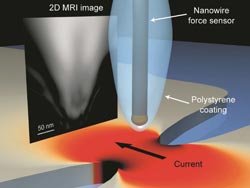A new paradigm for nanoscale resolution MRI has been experimentally achieved

Illustration of the experimental setup shows the two unique components of the teams novel MRI technique that was successful in producing a 2D MRI image with spatial resolution on the nanoscale. <br>
This represents a significant advance in MRI sensitivity—modern MRI techniques commonly used in medical imaging yield spatial resolutions on the millimeter length scale, with the highest-resolution experimental instruments giving spatial resolution of a few micrometers.
“This is a very promising experimental result,” said U. of I. physicist Raffi Budakian, who led the research effort. “Our approach brings MRI one step closer in its eventual progress toward atomic-scale imaging.”
MRI is used widely in clinical practice to distinguish pathologic tissue from normal tissue. It is noninvasive and harmless to the patient, using strong magnetic fields and non-ionizing electromagnetic fields in the radio frequency range, unlike CT scans and tradiational X-rays, which both use more harmful ionizing radiation.
MRI uses static and time-dependent magnetic fields to detect the collective response of large ensembles of nuclear spins from molecules localized within millimeter-scale volumes in the body. Increasing the detection resolution from the millimeter to nanometer range would be a technological dream come true.
The team’s breakthrough—the new technique introduces two unique components to overcome obstacles to applying classic pulsed magnetic resonance techniques in nanoscale systems. First, a novel protocol for spin manipulation applies periodic radio-frequency magnetic field pulses to encode temporal correlations in the statistical polarization of nuclear spins in the sample. Second, a nanoscale metal constriction focuses current, generating intense magnetic field-pulses.
In their proof-of-principal demonstration, the team used an ultrasensitive magnetic resonance sensor based on a silicon nanowire oscillator to reconstruct a two-dimensional projection image of the proton density in a polystyrene sample at nanoscale spatial resolution.
“We expect this new technique to become a paradigm for nanoscale magnetic-resonance imaging and spectroscopy into the future,” added Budakian. “It is compatible with and can be incorporated into existing conventional MRI technologies.”
The team’s paper, “Nanoscale Fourier-Transform Magnetic Resonance Imaging,” is published in Physical Review X, v. 3, issue 3, 031016.
Contact: Raffi Budakian, Department of Physics, University of Illinois at Urbana-Champaign, 217/333-3065.
Siv Schwink, Department of Physics, 217/552-5671.
Media Contact
More Information:
http://www.illinois.eduAll latest news from the category: Physics and Astronomy
This area deals with the fundamental laws and building blocks of nature and how they interact, the properties and the behavior of matter, and research into space and time and their structures.
innovations-report provides in-depth reports and articles on subjects such as astrophysics, laser technologies, nuclear, quantum, particle and solid-state physics, nanotechnologies, planetary research and findings (Mars, Venus) and developments related to the Hubble Telescope.
Newest articles

Sea slugs inspire highly stretchable biomedical sensor
USC Viterbi School of Engineering researcher Hangbo Zhao presents findings on highly stretchable and customizable microneedles for application in fields including neuroscience, tissue engineering, and wearable bioelectronics. The revolution in…

Twisting and binding matter waves with photons in a cavity
Precisely measuring the energy states of individual atoms has been a historical challenge for physicists due to atomic recoil. When an atom interacts with a photon, the atom “recoils” in…

Nanotubes, nanoparticles, and antibodies detect tiny amounts of fentanyl
New sensor is six orders of magnitude more sensitive than the next best thing. A research team at Pitt led by Alexander Star, a chemistry professor in the Kenneth P. Dietrich…





















